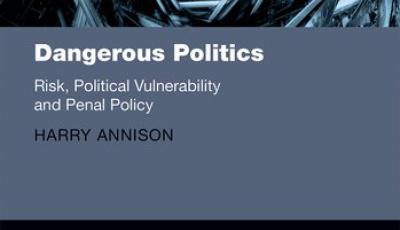Post by Harry Annison. Harry completed his DPhil in Criminology at Oxford in 2013 under the supervision of Professor Ian Loader, and his doctoral research formed the basis of Dangerous Politics (2015), published as part of the Clarendon Studies in Criminology series by Oxford University Press. He is currently a Lecturer in Criminal Law and Criminology at the Law School, Southampton University.

This monograph makes two important contributions, which we can term historical and interpretive. First, it provides important insights into who contributed to specific policy developments, and how. A task, in other words, of careful historical reconstruction (more on the specific case study presented in Dangerous Politics below). Second, it provides what interpretive politics scholar RAW Rhodes terms ‘my interpretation of policymakers’ interpretations of what the world looks like through their eyes.’ A robust, nuanced account of what policymakers thought they were doing, and their motivations for acting as they did.
The research is centred upon what I term the IPP story―the creation, contestation, amendment, and legislative abolition of the Imprisonment for Public Protection (IPP) sentence introduced in the Criminal Justice Act 2003. An indeterminate sentence targeted at ‘dangerous offenders’, its effects have been dramatic. At its peak, over 6,000 prisoners were serving IPP sentences―effectively life sentences where release is only possible if the prisoner can ‘prove a negative,’ that they are no longer dangerous. Over four thousand still remain, notwithstanding the abolition of the sentence in 2012.
The situation has proved to be extremely difficult for many of those remaining IPP prisoners, who find that under-resourcing of the prison system and risk aversion has made it near-impossible for them to make reasonably timely progress towards release. Prisoners’ families are becoming increasingly desperate as their lives are effectively put on hold. Politicians including David Blunkett, Home Secretary at the time of its introduction, have expressed ‘regret’ at the ‘prolonged and over-prolonged incarceration of many of these prisoners.’
The IPP story also speaks to themes familiar in the criminological literature: the rise of risk as an organising concept in criminal justice policy; the dominance of populist rhetoric and action in the realm of penal politics; and the continued expansion of preventive justice. Measures targeted at ‘dangerous offenders’ proliferated across much of Europe, Australia, and the United States in the early 2000s. They have been, and will continue to be, a recurring theme of criminal justice. This study of the IPP story stands as a cautionary tale, with important lessons for nations that continue to pursue preventive goals.
Dangerous Politics brings together relevant literature in law, criminology, and politics to provide insights into the beliefs and practices of ministers, the judiciary, civil servants, pressure groups, and other key policy participants in criminal justice politics. Spanning both Labour and Conservative-led governments, it’s an invaluable resource for those wishing better to understand penal politics and policymaking.
Share:
